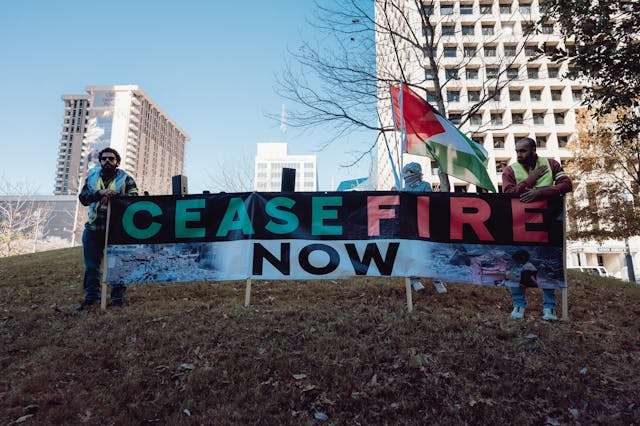The ongoing conflict between Hamas and Israel has once again reached a critical turning point. In a significant move, Hamas has proposed a complete ceasefire, offering to release all captives held in Gaza in exchange for an end to Israel’s military operations and a full withdrawal of Israeli forces from the enclave.
This bold proposal has sparked global discussions, raising questions about whether this could be the breakthrough needed to bring peace or if Israel will reject the deal and continue its offensive.
Hamas Ceasefire Proposal: Key Details
On Wednesday, Hamas spokesman Hazem Qassem outlined the group’s vision for the second phase of the Hamas ceasefire agreement. The proposal includes the release of all captives “in one go,” provided Israel agrees to a permanent truce and completely withdraws its forces from Gaza.
“We are ready for a second phase in which the prisoners will be exchanged in one go, within the criterion of reaching an agreement that leads to a permanent ceasefire and a complete withdrawal from the Strip,” Qassem said in a statement.
However, Hamas made it clear that it rejects Israel’s demands for its disarmament and removal from Gaza, calling such conditions a psychological tactic rather than a genuine effort toward peace.
“The occupation’s condition of removing Hamas from the Gaza Strip is a ridiculous psychological war, and the withdrawal or disarmament of the resistance from Gaza is unacceptable,” Qassem added.
Why Hamas Is Doubling the Number of Captive Releases
Hamas also announced an increase in the number of captives to be released in the next prisoner swap. Initially set at three, the number has now been doubled to six, a move aimed at expediting the Hamas ceasefire negotiations.
Hamas leader Khalil al-Hayya confirmed the decision a day earlier, emphasizing that the move was made at the request of mediators to show Hamas’ commitment to implementing all aspects of the agreement.
“Doubling the number of prisoners to be released was done in response to a request from the mediators and to prove our seriousness in implementing all the terms of the agreement,” Qassem said.
This shift comes after increasing pressure from international mediators and families of Israeli captives who have urged for the immediate release of all detainees rather than a phased release.
Israel’s Response and Continued Military Actions

Despite the Hamas ceasefire offer, Israel has shown no immediate signs of accepting the proposal. Instead, Israeli forces have continued their operations, maintaining control over vital border crossings and blocking the entry of essential supplies and reconstruction materials.
Recent reports indicate that Israeli forces have intensified their offensive, targeting key areas in Gaza. Meanwhile, Israeli Prime Minister Benjamin Netanyahu has faced pressure from both hardliners within his government and international communities over how to proceed with the ceasefire negotiations.
While far-right ministers in Netanyahu’s cabinet have pushed for a military occupation of Gaza, there has also been growing opposition within Israel demanding an end to the war and a diplomatic resolution.
The Humanitarian Crisis in Gaza
As the conflict drags on, the humanitarian situation in Gaza has reached catastrophic levels. The Hamas ceasefire proposal comes at a time when Gaza’s health ministry has confirmed 48,291 deaths, with another 111,722 people wounded due to Israeli attacks.
The Government Media Office has further updated the death toll to at least 61,709, stating that thousands of missing Palestinians trapped under rubble are now presumed dead.
With Israeli airstrikes and military blockades worsening the situation, the World Bank, United Nations, and European Union have estimated that rebuilding Gaza will cost $53.2 billion, including approximately $15.2 billion needed for housing alone.
Hamas Ceasefire Proposal: Geopolitical Reactions and International Pressure
The Hamas ceasefire proposal has also triggered reactions from major international players. The United States, United Nations, and European allies have urged both sides to find a diplomatic solution to the ongoing crisis.
However, the Biden administration’s stance has remained somewhat ambiguous. While publicly advocating for a ceasefire, the U.S. has continued to support Israel militarily, leading to accusations of double standards in its foreign policy.
Meanwhile, protests and demonstrations worldwide have intensified, with activists calling for an end to Israeli aggression and urging Western nations to take a stronger stance against human rights violations in Gaza.
Challenges Ahead: The Next Phases of the Ceasefire Deal
According to Marwan Bishara, a senior political analyst for Al Jazeera, the biggest challenge in the Hamas ceasefire deal will not be phase one, but phases two and three.
“The problem for Israel is that despite having the upper hand, it’s not able to defeat Hamas,” he said. “But here we are, and Israel is dictating the process—when and where aid goes in. And as long as those alternative housing units are not getting in, it’s making things quite difficult for the Palestinians”.
The ceasefire agreement, which came into effect on January 19, has already been violated multiple times by Israel, with reports suggesting that Netanyahu’s government is considering a return to all-out war in Gaza.
Since the agreement, a total of 1,135 Palestinians have been freed from Israeli prisons, with another 502 set to be released this week. On the other hand, Hamas and Palestinian Islamic Jihad have released 25 Israeli captives since January 19.
With both sides accusing each other of violating terms, the question remains—Will the Hamas ceasefire hold, or will the conflict escalate once again?
Conclusion: A Moment of Decision
The Hamas ceasefire proposal marks a significant moment in the ongoing conflict, offering a potential pathway to peace. However, the future of this deal depends on whether Israel is willing to accept the terms or continue its military actions in Gaza.
As global pressure mounts and the humanitarian crisis worsens, the world watches closely—Will this ceasefire bring lasting peace, or is another escalation inevitable?
📢 For more in-depth coverage on global conflicts, diplomacy, and untold stories, visit Documentary Times – Your trusted source for insightful journalism!